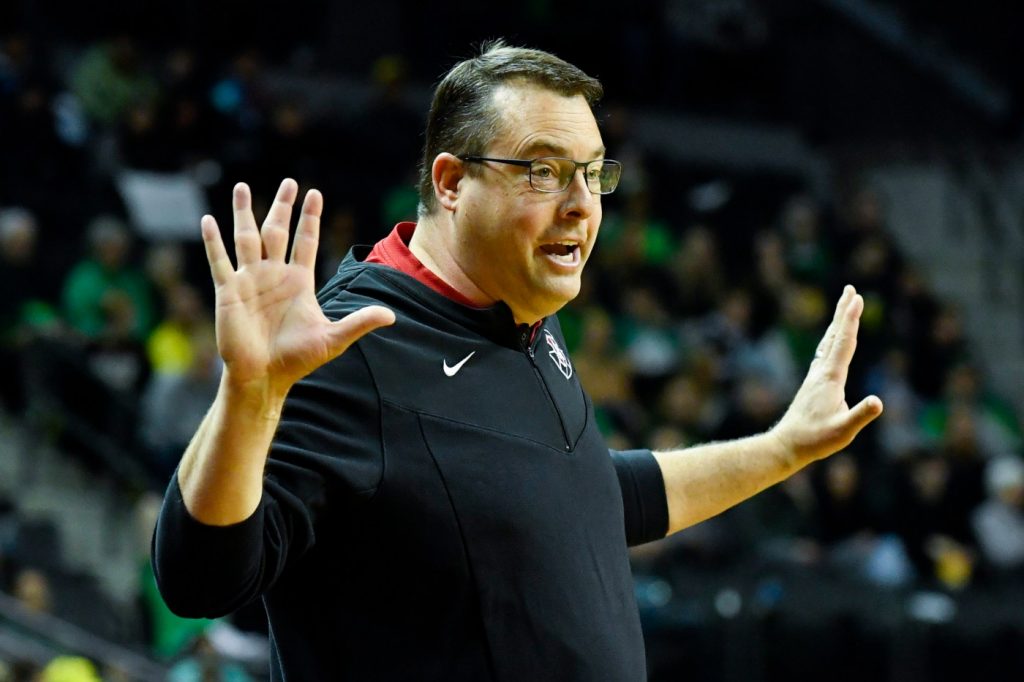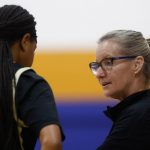Another disappointing Stanford basketball season had just ended when athletic Bernard Muir released a statement indicating coach Jerod Haase would not be dismissed. Quite the opposite, in fact. Muir thought the future was bright under Haase’s stewardship.
“I believe that the young nucleus of talent on our team and promising recruiting will propel us to take the next steps we all desire,” Muir explained back in March 2022.
Two years later, the Cardinal hasn’t taken “the next steps.” It has remained stuck in an endless cycle of mediocrity that has come to define Haase’s eight-season tenure.
And some of the greatest players in school history have had enough.
“It has been a rough go,” said former All-American Casey Jacobsen, a college basketball analyst for Fox.
“I’m sensitive to calling out an individual when I’m not in the locker room every day and don’t know what’s going on every day. But I watch that team play more than anyone who’s not in the locker room, and I study that team more than anyone who’s not in the locker room, and it’s not pretty.
“Everyone needs to look in the mirror. Bernard needs to look in the mirror. Jerod needs to look in the mirror. The assistant coaches need to look in the mirror, and all the players do, too. That’s the reality.”
Asked if Haase should be fired, Jacobsen said: “Yes, I believe a coaching change needs to be made.”
He’s not alone. Former guard Todd Licthi, the only four-time all-Pac-12 selection in Stanford history, sees no other option.
“I don’t know why it’s not working,” Lichti said, “but it’s silly to think a change isn’t required. What should change? I’m not in position to make that decision. But it’s certainly needed and, in sports, the easiest thing is to change coaches.”
Is this it for Haase?
Muir issued the following statement to the Hotline:
“Stanford has a deep history of men’s basketball success, and I can understand why the on-court outcomes of recent seasons have been disappointing to many Cardinal supporters. As with each sport, we will conduct a thorough evaluation of all aspects of the program at the conclusion of the season.”
All aspects need evaluation, according to Josh Childress, a former Pac-12 Player of the Year and the highest NBA Draft pick Stanford has ever produced (No. 6 in 2004).
He declined to address Haase’s situation specifically but is “optimistic” that “the university and athletic department will invest the time and resources into getting Stanford back to where it belongs.”
“Changes are needed,” he added. “The last 10 years have been challenging to watch as a Stanford fan.”
It has been more than 10, actually.
Under coach Mike Montgomery and his successor, Trent Johnson, Stanford qualified for the NCAA Tournament 13 times in a 14-year stretch. The run included a Final Four appearance in 1998, three No. 1 seeds and four conference championships.
For a decade and a half, the Cardinal stood alongside Arizona and UCLA as the preeminent programs in the West.
But Johnson departed for LSU in the spring of 2008, following a run to the Sweet 16, and the Cardinal has floundered ever since under Johnny Dawkins and Haase, who took over in the spring of 2016.
“If the current team doesn’t win the Pac-12 tournament, Stanford will have one NCAA appearance (2014) in the past 16 years,” Jacobsen said. “That’s unfathomable to say out loud and wrap my head around.
“But I want to be clear. I don’t have the expectation that the program will operate at that level, that it will be in the top 10 regularly and win the Pac-12. I try to be realistic because of the changing college sports landscape.
“My standard is to be relevant nationally and make the NCAAs on a regular or semi-regular basis. And Stanford is not close to meeting that standard.”
The former players were quick to acknowledge external challenges facing Haase and the program, with NIL (name, image and likeness) and the transfer portal atop the list. Those same issues, Childress noted, have proved daunting for Stanford’s football program.
“The landscape has shifted,” he said, “and you don’t have to look any further than Stanford playing in the ACC (next season). We are just behind. As a university, we’re so cutting edge. But athletics has not mirrored that.”
NIL and the transfer portal affect roster construction, but a dearth of talent isn’t why Stanford is stuck in the muck under Haase.
“He has recruited better than any coach in the history of the program based on how the players are ranked,” Lichti said.
Haase’s first class, which signed letters of intent during the 2016-17 recruiting cycle, featured a trio of blue-chip projects (i.e., players with four- or five-star rankings in the 247Sports database): Daejon Davis, KZ Okpala, who became a second-round NBA Draft pick, and Oscar da Silva, a two-time all-conference selection.
Haase’s second class also had three four-star recruits.
The momentum hasn’t slowed despite the lack of on-court success. This year’s freshman class includes Andrej Stojakovic, a five-star recruit and McDonald’s All-American selection, and Kanaan Carlyle, a four-star prospect who had a scholarship offer from Kansas.
In all, Haase has signed 16 blue-chip prospects in seven recruiting cycles (2017-23). His current roster has six of them. Yet Stanford is mired in 10th place and has lost six consecutive games — all by double digits.
“If you can’t recruit, that’s a tough one,” Jacobsen said. “If the talent is still pretty good and you’re not getting the results, that’s a different problem.
“It’s frustrating to watch a program that has talent not get better over the course of the year — and not get better over the course of a couple years with the same group.”
Three of the top five scorers on this year’s team (Maxime Raynaud, Spencer Jones and Brandon Angel) were on the 2022 edition that was the source of Muir’s optimistic outlook.
“Something isn’t connecting as it should,” Lichti said. “It seems like in a lot of seasons, they start well, hit a flat spot, then taper off. And it’s happening again.”
Stanford has consistently saved its worst for last over the course of Haase’s tenure. In the first half of conference action, the Cardinal is 38-38 under Haase. In the second half of round-robin play, the record drops to 28-47.
In 2020, Stanford lost seven of its last 11 games (including the Pac-12 tournament result).
In 2021, it ended the season with a five-game losing streak.
In 2022, it dropped eight of the last 10.
Last year, it lost seven of the last 11.
This year, the Cardinal has dropped eight of its past nine.
“That’s black and white — there is no excuse,” Jacobsen said. “I have never coached college basketball, and if my team wasn’t getting better over the course of a season, I would look inward as a player.
“But the coach’s responsibility is to all the players, the entire group, to figure out why something is happening over and over. And to try to fix it.”
Do the players run out of steam late in the season? Do they lose motivation? Or does the coaching staff fail to make the necessary adjustments in the second half of conference play, when tactics and tendencies are on video for opponents to scout?
“I’d argue that if adjustments are being made,” Lichti said, “then the rest of the (conference) is making more effective adjustments.”
The former players are concerned about other matters, as well.
Lichti pointed to an absence of “the underlying toughness that was a hallmark of Montgomery’s teams” and noted that many players don’t appear to improve over the course of the season.
Childress has “always wondered” why Haase didn’t include a former Stanford player on his coaching staff. “Stanford is a unique place,” he said, “and an individual with knowledge of what it takes to win is important.”
Jacobsen pointed to the absence of efficiency on both ends of the court.
In the first six years of Haase’s tenure, the Cardinal ranked 142nd nationally (on average) in adjusted offensive efficiency, according to the well-regarded Pomeroy metrics; meanwhile, it was a solid 58th (on average) in adjusted defensive efficiency.
But in the past two seasons, that has flipped: Stanford is in the top 100 in offensive efficiency but sorely lacking on defense (157th last season, 144th this season).
“It’s frustrating that we don’t have any balance,” he said.
Toss all the deficiencies into a cauldron — the inefficiency, the lack of toughness, the floundering finishes and the talent that doesn’t translate to victories — and the result is an undeniable, enduring mediocrity.
In eight seasons under Haase, Stanford has produced a winning record in Pac-12 play just once: in 2018, when the Cardinal finished in a three-way tie for third place.
Since then, it has not placed higher than sixth in the conference race.
Haase has never reached the semifinals of the Pac-12 tournament, and he has never been to the NCAAs. (Stanford was considered a bubble team in 2020, when the event was canceled before Selection Sunday.)
His overall record: 124-16.
His record in conference play: 66-85.
“I can’t answer whether Jerod is getting the fiscal support and the university support,” Childress said. “But I know that the team lacks consistency. Are the problems the result of the staff? Partly. Are they a result of the university? Partly. Are they a result of the players? Partly. It’s probably a little of everything.”
Related Articles
McIntosh scores 17, Cal women clamp down on Washington State 65-44 in Pac-12 Tournament
Best of the West: Arizona on top, Gonzaga climbs and Utah State’s remarkable rise
Memorable moments in Cal, Stanford and Bay Area Pac-12 tournament history
Pac-12 collapse: Kliavkoff’s failed tenure ends with radio silence, no signs of remorse
Stanford trio earns top Pac-12 women’s hoops honors
Other programs have challenges, as well.
Cal was 2-18 in conference play last year, hired former Stanford star Mark Madsen and is two games ahead of the Cardinal in the standings entering tonight’s matchup. (Muir could have hired Madsen but chose instead to retain Haase.)
Washington State, with all its obstacles in tiny, remote Pullman, is a lock for the NCAA Tournament.
Utah, which finished four games behind Stanford in 2022, when Muir was so optimistic about the trajectory of the Haase regime, has overtaken the Cardinal in the standings.
“Excuses have been made to me, and I don’t buy into any of them,” Jacobsen said. “I don’t view Stanford’s academic standards as a negative.
“Yes, it’s more difficult to get transfers, but Stanford doesn’t have a talent issue. Is it more difficult to turn Stanford around in one season? Yes, I’m aware of that. But that’s not the only thing going on here …
“I’ve worked at Fox for 10 years. I do 50 studio shows a year — that’s a lot of shows on Fox or FS1. And I have never been asked by a producer or director to have a conversation on the air about Stanford.
“The reason? Stanford has been irrelevant for 10 years. And that hurts my heart.”
*** Send suggestions, comments and tips (confidentiality guaranteed) to [email protected] or call 408-920-5716
*** Follow me on Twitter/X: @WilnerHotline
*** Pac-12 Hotline is not endorsed or sponsored by the Pac-12 Conference, and the views expressed herein do not necessarily reflect the views of the Conference.


